How to Transition Carpet to Tile Without Transition Strip?
In order to gain warmth and a safe floor, many homeowners use carpet either in their bedroom or the living room. Although, in some areas of the house, the carpet does not seem to fit. ... Read more The post How to Transition Carpet to Tile Without Transition Strip? appeared first on Arthitectural.
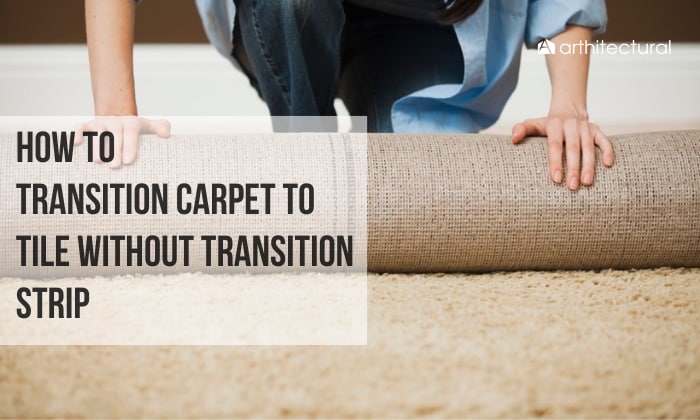

In order to gain warmth and a safe floor, many homeowners use carpet either in their bedroom or the living room. Although, in some areas of the house, the carpet does not seem to fit.
For example, in the kitchen, some homeowners prefer using tiles since tiles are easier to clean and maintain. If they use carpet here, they have to clean it often, not just clean, but it needs a thorough cleaning.
So this is when people start using floor transition strips carpet-to-tile. But, do you know how to transition carpet to tile without transition strip? It is easy, we have tack strips.
Step-by-step Carpet to Tile Transition Without Strip
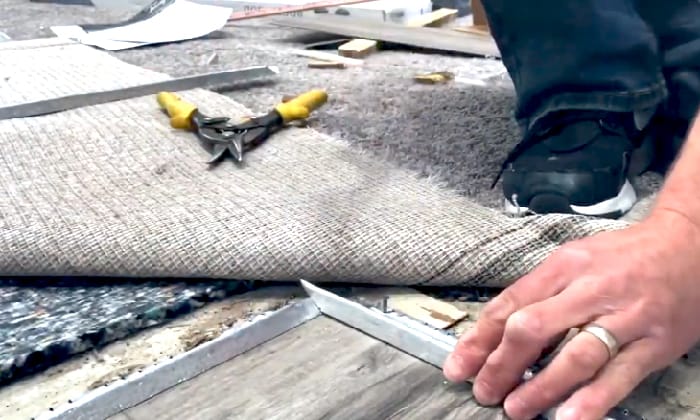
Besides the transition strip, one of the carpet-to-tile transition options is the tack strip.
What is this tack strip? Is it different from a transition strip?
Compared to a transition strip, tack strips are mostly made for carpet installations. The tack strip is technically not a transition strip. A transition strip joins two sections of a building.
A carpet tack strip is a piece of wood placed underneath a carpet for a smooth edge finish. It is used in joining a carpet with other flooring materials – either on wood, tiles, or even on concrete. Besides, it keeps the carpet in place and tucked in it without any visible strips and adhesives on top. This is easy to use and lasts long.
Things to Prepare
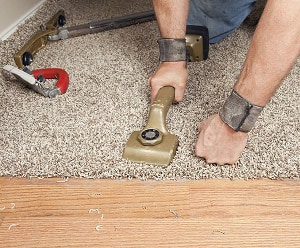
Here are the things you need to prepare to achieve a smooth transition from wide carpet to tile:
- Knife/Cutter
- Tack strip
- Concrete nails or glue
- Carpet kicker
- Putty knife
Step 1. Set the carpet
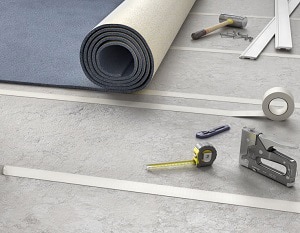
Before we can install the tack strip, the floorings must be set. There is no problem whichever the tiles and carpet are placed first or last. What’s important is that each of these floorings is cut to fit perfectly into that area.
If the tiles were already installed, keep in mind that their edges should be free from any residue before placing the carpet.
Now, here’s what you can do about this:
1. First of all, you need to purchase a carpet. In choosing one, pick a color that will complement the tiles in the same room for a smooth color transition from carpet to tile. This way, the room will be able to showcase a cozy vibe for you.
2. Clean the floor before placing the carpet, and keep it residue and dust-free.
3. Place the carpet on the floor and make sure that it reaches every edge of the wall and fits perfectly to the floor area.
4. Before cutting it, leave 1.5 inches of the carpet hanging. This is to have an allowance to where the edges of the two floorings will meet.
5. Secure the edge of the carpet with tape before installing the tack strip to protect it from fluffing.
6. Once the carpet was cut and has tape, clean the debris to prepare the floor for the next step.
Step 2. Install the tack strip
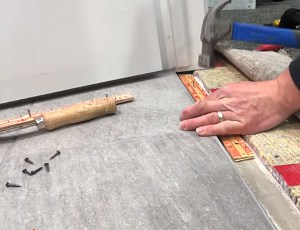
If you are aiming for a seamless transition between tile and carpet, install a tack strip. Some people also know this strip as nails since it has nails that are used to secure itself on the floor.
Take note that you will not attach the carpet to this strip. What you will do is tuck the carpet in it. There are two ways to secure the tack strip on the floor: either using glue or using nails to prevent it from moving.
1. The first thing you need to do is to lay the tack strip on the edge of the tile. This is the space between the tile and the carpet.
2. Most tack strips are 4 feet long or equivalent to 1.21 meters long and made of thin pieces of plywood. This is made so that the users will be able to cut them to the size needed.
So, if the tack strip is longer than the length that needs it, cut it.
3. Now that the strips are ready, get your hammer and concrete nails or glue and fasten the strip on the floor.
Note that if the flooring is concrete, you can use a concrete nail or glue that will adhere like construction adhesives.
Step 3. Stretch the carpet
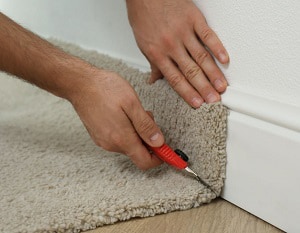
After securing the strip, you can now put the carpet on it. Here’s how to do it:
1. First, remove the tape placed on it on the first step.
2. Then, using a carpet kicker, properly stretch the carpet. This step can help you to prevent carpet wrinkles over time.
3. After stretching the carpet, you might see the excess carpet. What you can do is cut it.
Step 4. Tuck the carpet
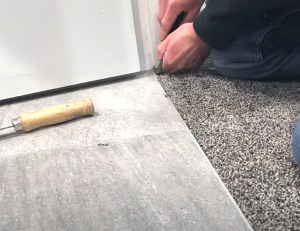
This is the final step, the tucking of the carpet:
1. Lock the carpet in place by pressing it in.
2. Get your putty knife to tuck the carpet to the tack strip.
3. Start from the side going to the middle until you reach the other side of the wall.
4. Then, tuck it in again for the second time around to ensure that you will have a smooth transition between carpet and tile.
Frequently Asked Questions

Tips to seam a carpet to tile
The best trick to seam a carpet to tile is to keep the transition seem invisible. And to achieve this, you need to do the following:
- Properly stretch the carpet from the edges to all edges of the wall.
- Use a transition strip if there is a height difference between the flooring.
- If the flooring has the same thickness, a tack strip is advisable to be used.
- If it seems that even with a strip there is a possibility that the carpet will be out of order, glue it to secure it in place.
How do you finish the edge between the carpet and tile?
Having a sleek and neat transition from a wide carpet to tile is one way to make your home look more polished and well-designed. Some of the ideas you can try to finish the edge between the carpet and tile are to use a strip to the edges.
In finding the right strip, you need to consider what is the height difference between the two floorings.
- If the two floorings have the same height, using a tack strip is a good choice.
- If there is a height difference, a transition strip must be chosen. Here are samples of transition strips:
- T-bar – This is a T-shaped bar used to transition from a hardwood floor to another floor with the same height and hardness. You can use adhesive and a nail to fasten it to the floor.
- Reducer molding – Reducer molding is the transition strip used for floorings with a difference in thickness, like a laminated floor and wood. This type of transition slip comes in different thicknesses and shades.
Are transition strips important?
Yes. Transition strips are widely used to cover the gap between two different materials. It is important to install carpet-to-tile transition strip if you have two different flooring with different thicknesses. This is because tack strips are made only for two different flooring with the same height.
For a carpet-to-tile transition of different heights, using a transition strip is also the safest option. This will keep the homeowners safe and will prevent them from tripping over.
Conclusion
For a carpet-to-tile transition, no strip visible is the best transition. Having this smooth transition from carpet to tile will achieve a modern and contemporary look for your home.
So, how to transition carpet to tile without transition strip? Using a tack strip is the key. The tack strip is easy to install and will give you that seamless transition you are aiming for.
The post How to Transition Carpet to Tile Without Transition Strip? appeared first on Arthitectural.
